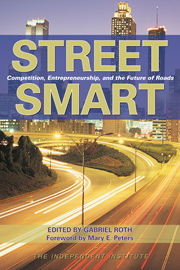When you look at America’s transportation network broadly, there can be little doubt that getting government out of the passenger train business would likely improve safety.
Though government officials talk ceaselessly about safety, it’s clearly not their top priority.
If you want proof, consider the U.S. Department of Transportation’s fuel-economy standards for cars and light trucks.
Dating back to the 1970s, the Corporate Average Fuel Economy regulations, which continue to get ratcheted up, are intended to increase the overall fuel economy of all the cars and light trucks on U.S. roads.
To meet these standards, automakers had to reduce vehicle weight, making them less crashworthy—and increasing deaths.
The National Highway Traffic Safety Administration estimated in 1991 that road fatalities were up some 2,000 per year and serious injuries were up 20,000 per year as a result of vehicle downsizing in the 1970s and 1980s.
Are these casualties a sign that safety is Washington’s top transportation priority, or are they a sign that another agenda—opposition to fossil fuels, perhaps—is at work?
Make no mistake: If a private transportation company were to announce that it was going to reduce safety to save fuel a national outcry would ensue.
The White House, Congress and the media would go nuts. But, strangely, when government does it there is silence.
The war on fossil fuels continues—and has been stepped up by the Obama administration as it pursues its green energy agenda.
That, of course, is what the Keystone XL pipeline controversy is all about: administration opposition to fossil fuels.
Without such pipelines, however, energy companies are forced to ship oil products by truck and railroad, which are significantly more accident-prone than pipelines.
Is this another demonstration of Washington’s commitment to safety?
There are reasons that private transportation companies as a general rule pay more attention to safety than government, whose actions are mired in politics.
Private companies have strong commercial incentives to focus on safety. Not only does safety attract passengers, it also reduces insurance premiums. And in the case of a serious accident, a company can be on the hook for a fortune.
In contrast, Amtrak’s liability in any “incident,” including the recent Philadelphia derailment that killed eight passengers and left more than 200 others injured, is capped by law at $200 million.
That’s a lot of money, but in the world of liability awards it’s small potatoes — not a huge incentive to make safety the top priority.
Another reason a privately owned and operated passenger rail system would likely have a better safety record is because private management—freed from the political reins—would spend money more wisely.
Several existing technologies can prevent trains from going at excessive speeds. Some trigger crew alarms. The most advanced—Positive Train Control, which we’ve heard much about since the Philadelphia derailment—can also apply the brakes.
Amtrak in 2008 was ordered to install PTC on its busiest routes—those in the northeast corridor, connecting Washington, Philadelphia, New York and Boston.
The job was never completed. Part of the reason is because Congress also requires Amtrak to operate rail service in areas where there aren’t enough passengers to cover operating costs. Money that should be spent on safety upgrades was used instead to subsidize these routes.
Getting government out of the rail passenger business would free management to align service with passenger demand, and focus on quality and safety, rather than satisfying political constituencies.








